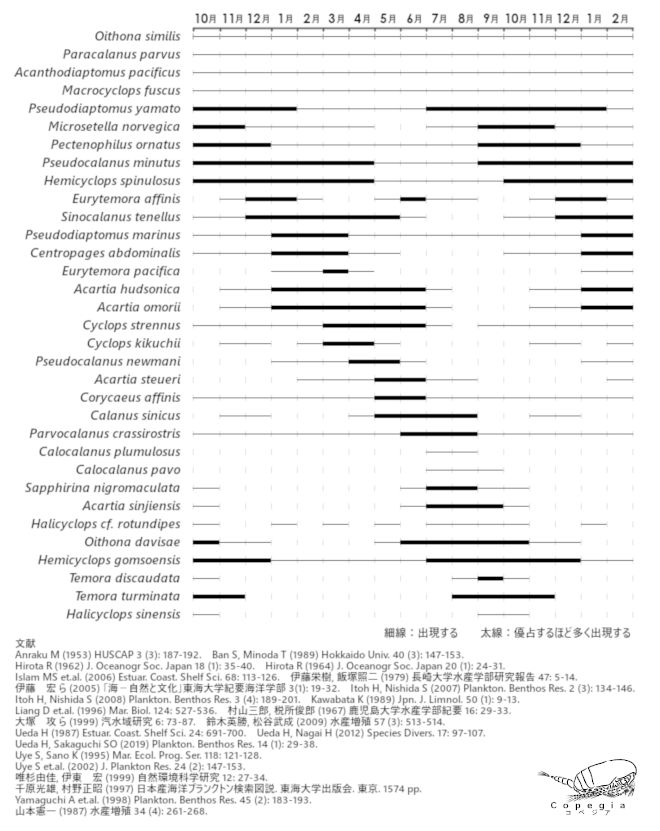カイアシ類の季節的消長
カイアシ類とは、微小な甲殻類だが、多くはプランクトンとして浮遊生活をしている。実は、水柱に出現する時期には法則性があり、季節的な消長がある。これを「季節的消長」と呼ぶ。この類語として「季節的変動」、「季節的変化」がある。英語では、seasonal occurrence、seasonal change、seasonal variation、seasonal patternなど様々あり、それぞれの意味合いは若干変わるものも大体は同じことを指す。
季節的消長を示すにはいくつかの理由がある。1つに餌である。カイアシ類の餌となるのは植物プランクトンがあるが、植物プランクトンは十分な光がないと増殖ができない。すなわち、春から秋までの期間が増殖に適している。逆に冬の間は数を減らしてしまう。その食糧不足にカイアシ類は飢餓状態になり、最悪、死滅する。それを避けるため、代謝を落とし、休眠をする。休眠をする場所は、大抵は底泥中で、水柱からは姿を消す。
2つに魚類などの捕食圧があげられる。夏になると魚類の餌となるカイアシ類などのプランクトンが多くなると、魚類の活動は活発になる。したがって、カイアシ類への捕食圧は高くなる。そこで、夏の間は、捕食圧から避けるために休眠するわけだ。
他に、餌の捕食効率の差による競争から避けるために、捕食効率が優秀な種が出現している間は、休眠することがあげられる。
季節的消長をする理由は様々あるが、共通した点は、いかに悪環境の中を生き抜くかである。休眠をする多くは、休眠卵という、特殊な卵で過ごすものが多い。その休眠卵は、低酸素や乾燥などに強く、抗菌性も知られている。万が一、魚類に捕食されても、消化されず、生きたまま消化管を通過することができるという(Hairston and Munns 1984)。
今回、陸水~沿岸(湾内)で見られるカイアシ類の季節的消長を図に示した(Fig. 1)。種によって、水柱に出現する時期が異なることが分かる。一種に、ホタテガイに寄生するPectenophilus ornatusも加えられているが、寄生率に季節性があるということを知ってもらいたく示した。筆者は、毎月にホタテガイを解剖して、P. ornatusの寄生状況を調べた時があったが、12月に近づくたびに1個体のホタテガイに寄生するP. ornatusの寄生個体が増え、体長サイズが大きくなるという面白い結果を得られた。これは鈴木、松谷(2009)と同様な結果である。話がそれてしまったが、33種の季節的消長の図を示したところで終えたい。

文 献
Anraku M (1953) Seasonal distribution of pelagic copepods at Oshoro bay, west coast of Hokkaido. HUSCAP 3 (3): 187-192.
Ban S, Minoda T (1989) Seasonal distribution of Eurytemora affinis (Poppe, 1880) (Copepoda; Calanoida) in freshwater lake Ohmura, Hokkaido. Bull. Fac. Fish. Hokkaido Univ. 40 (3): 147-153.
伴 修平 (1998) 橈脚類の休眠. 海の研究 7 (1): 21-34.
Hairston N G, Munns J W R (1984) The timing of copepod diapause as an evolutionarily stable strategy. Am. Nat. 123: 733-751.
Hirota R (1962) Species composition and seasonal change of copepod fauna in the vicinity of Mukaishima. J. Oceanogr Soc. Japan 18 (1): 35-40.
Hirota R (1964) Zooplankton investigation in Hiuchi-nada in the Setonaikai (Inland Sea of Japan) I. The seasonal occurrence of copepods at the three stations in Hiuchi-nada. J. Oceanogr Soc. Japan 20 (1): 24-31.
Islam M S, Ueda H, Tanaka M (2006) Spatial and seasonal variations in copepod communities related to turbidity maximum along the Chikugo estuarine gradient in the upper Ariake Bay, Japan. Estuar. Coast. Shelf Sci. 68: 113-126.
伊藤栄樹, 飯塚照二 (1979) 大村湾における動物プランクトンに関する研究-I 橈脚類の季節的出現. 長崎大学水産学部研究報告 47: 5-14.
伊藤 宏, 水島 毅, 久保田 正 (2005) 駿河湾三保沖におけるカラヌス目カイアシ類の季節的消長. 「海-自然と文化」東海大学紀要海洋学部 3(1): 19-32.
Itoh H, Nishida S (2007) Life history of the copepod Hemicyclops gomsoensis (Poecilostomatoida, Clausidiidae) associated with decapod burrows in the Tama-River estuary, central Japan. Plankton. Benthos Res. 2 (3): 134-146.
Itoh H, Nishida S (2008) Life history of the copepod Hemicyclops spinulosus (Poecilostomatoida, Clausidiidae) associated with crab burrows with notes on male polymorphism and precopulatory mate guarding. Plankton. Benthos Res. 3 (4): 189-201.
Kawabata K (1989) Seasonal changes in abundance and vertical distribution of Mesocyclops thermocyclopoides, cyclops vicinus and Daphnia longispina in Lake Biwa. Jpn. J. Limnol. 50 (1): 9-13.
Liang D, Uye S, Onbé T (1996) Population dynamics and production of the planktonic copepods in a eutrophic inlet of the Inland Sea of Japan. I. Centropages abdominalis. Mar. Biol. 124: 527-536.
村山三郎, 税所俊郎 (1967) 池田湖のプランクトンについて. 鹿児島大学水産学部紀要 16: 29-33.
大塚 攻, 星名昭美, 清家 泰, 大谷修司, 國井秀伸 (1999) 中海本庄工区内外における動物プランクトン群集の季節変動. 汽水域研究 6: 73-87.
鈴木英勝, 松谷武成 (2009) ホタテガイ稚貝におけるカイアシ類、ホタテエラカザリの寄生状況. 水産増殖 57 (3): 513-514.
Ueda H (1987) Temporal and spatial distribution of the two closely related Acartia species A. omorii and A. hudsonica (Copepoda, Calanoida) in a small inlet water of Japan. Estuar. Coast. Shelf Sci. 24: 691-700.
Ueda H, Nagai H (2012) Two new species of Halicyclops (Crustacea: Copepoda: Cyclopidae) from Honshu with a key to the species of the genus in Japan. Species Divers. 17: 97-107.
Ueda H, Sakaguchi S O (2019) Pseudodiaptomus yamato n. sp. (Copepoda, Calanoida) endemic to Japan, with redescriptions of the two closely related species P. inopinus Burckhardt and P. japonicus Kikuchi. Plankton. Benthos Res. 14 (1): 29-38.
Uye S, Sano K (1995) Seasonal reproductive biology of the small cyclopoid copepod Oithona davisae in a temperate eutrophic inlet. Mar. Ecol. Prog. Ser. 118: 121-128.
Uye S, Aoto I, Onbé T (2002) Seasonal population dynamics and production of Microsettela norvegica, a widely distribution but little-studies marine planktonic harpacticoid copepod. J. Plankton Res. 24 (2): 143-153.
唯杉由佳, 伊東 宏 (1999) 多摩川感潮域における動物プランクトン、特にカイアシ類の季節的消長. 自然環境科学研究 12: 27-34.
千原光雄, 村野正昭 (1997) 日本産海洋プランクトン検索図説. 東海大学出版会. 東京. 1574 pp.
Yamaguchi A, Ikeda T, Shiga N (1998) Population structure and life cycle of Pseudocalanus minutus and Pseudocalanus newmani (Copepoda: Calanoida) in Toyama Bay, southern Japan Sea. Plankton. Benthos Res. 45 (2): 183-193.
山本憲一 (1987) 水田におけるプランクトンの消長. 水産増殖 34 (4): 261-268.
